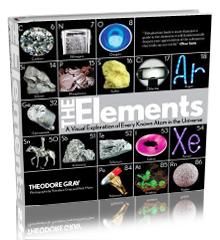Cesium formate brine. | |||
| Sample Image | Spin Video | QuickTimeVR Rotation | |||
| Cesium formate brine. In the oil well industry, where this amazing liquid is used, the term "brine" refers to a clear fluid containing fully dissolved salts such as calcium chloride, calcium bromide, or if you're lucky, cesium formate. The purpose of these dissolved salts is simply to increase the density of the fluid, to make it better able to lift rock chips up from the bottom of an oil well as it's being drilled. This cesium formate brine, very kindly donated by the Cabot Corporation, is so dense, 2.2 grams per cubic centimeter (water is one g/cc), that metal parts made of solid magnesium will float on the surface. (The density of magnesium is 1.7 g/cc.) If it were just a hair denser, 2.7 g/cc, even aluminum would float on it. Very few clear liquids are denser, one example being cesium tungstate at about 3 g/cc, dense enough to literally float rock. What you see here is a magnesium bicycle part floating on a glass full of cesium formate brine. Source: Cabot Corporation Contributor: Cabot Corporation Acquired: 28 March, 2009 Text Updated: 29 March, 2009 Price: Donated Size: 2" Purity: 75% | |||
|

